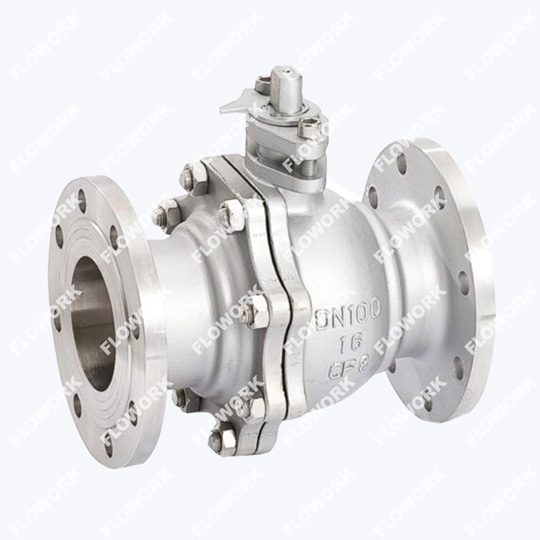
1、You are in restricted area and need password. Please Contact us to obtain documents.
2、PasswordIf you have any questions about quotation or cooperation, please feel free to send us inquiry. Inquiry us
| Size: | 2"-10" |
| Pressure: | 150LB-2500LB |
| Body Material: | WCB, WC6, WC9, CF8, CF8M, CF3, CF3M, CN7M, LC1, LC2, LC3, LCB, LCC, Monel, 20# Alloys, 4A, 5A, C95800, C95500, A105, F304, F304L, F316, F316L, LF1, LF2, LF3, LF9, F51, F53, F11, F22, etc. |
| Seal Material: | PEEK, RPTFE, PTFE, DEVLON, HNBR, NYLON, AFLAS, STELLITE,etc. |
| Connection Type: | Flanged, Butt Welded, Socket Welded, NPT |
| Operation: | Hand lever, gear operated, pneumatic, motorized |
| Face to Face Dimension: | ASME B16.10 |
| Flange End Dimension: | ASME B16.5 |
| Butt Welded Dimension: | ASME B16.25 |
| Design and Manufacture: | API 6D |
| Test Standard: | API 598, API 607, API 6FA, ISO 15848-1-2 |
Simple structure: 2-pieces or 3-pieces design
Suitable for small diameter pipelines of low or middle pressure
End connection: flanged, bw ends, sw ends, npt ends
Fire-safe, anti-static design and blow-out proof stem design
O-ring material can be viton or HNBR according to different requirements
Full bore or reduced bore; soft seal or hard seal
PTFE or graphite packing seal are normally adopted.
Can be equipped with a locking device to avoid improper operation
Operation device: lever, gear, pneumatic actuator, electric actuator, etc.
Ball valves are used for a wide range of applications where flow control is required. They are typically used to regulate the flow of fluids, such as water, oil, gas, and chemicals, in pipelines, tanks, and other systems. Some common applications of ball valves include:
Shut-off valves: Ball valves are commonly used as shut-off valves to stop the flow of fluid completely. They are often used in pipelines, tanks, and other systems where the flow of fluid needs to be controlled or stopped, ball valve manufacture.
Process control: Ball valves are used in industrial processes to control the flow of fluids and gases. They are often used in chemical, pharmaceutical, and food processing industries, among others.
HVAC systems: Ball valves are used in heating, ventilation, and air conditioning (HVAC) systems to control the flow of hot or cold water or air.
Fire protection systems: Ball valves are used in fire protection systems to control the flow of water or other fire suppression agents.
Irrigation systems: Ball valves are used in irrigation systems to control the flow of water to crops or other plants, gate valve manufacture.
Fuel systems: Ball valves are used in fuel systems to regulate the flow of gasoline, diesel, or other fuels.
Yes, a leaking ball valve can often be repaired, depending on the severity and cause of the leak. In some cases, repairing the valve may simply require tightening or replacing the valve stem packing, which is the material around the valve stem that seals the valve and prevents leaks. If the leak is coming from the valve body or the valve seat, more extensive repairs may be required, bronze valve.
Replacing a ball valve handle is a relatively straightforward process that can be completed using a few simple tools. Here are the general steps to replace a ball valve handle:
Turn off the valve: Before replacing the ball valve handle, it is important to turn off the valve and relieve any pressure in the system. This will help ensure that the valve can be safely disassembled and the handle replaced.
Remove the old handle: Locate the fasteners that secure the old handle to the valve stem. These may be screws, bolts, or a locking pin. Use a screwdriver, wrench, or pliers to remove the fasteners and detach the old handle from the valve stem.
Choose a new handle: Select a replacement handle that is compatible with the valve stem and the intended use of the valve. Choose a handle that is appropriate for the size and type of valve and that is made from materials that are compatible with the fluid being handled, api 6d ball valve.
Attach the new handle: Place the new handle over the valve stem and secure it using the appropriate fasteners. Make sure that the handle is properly aligned and tightened to ensure proper operation of the valve.
Test the valve: After replacing the handle, test the valve to ensure that it is operating properly. Open and close the valve several times to ensure that the handle is properly attached and that there are no leaks or other issues, high temperature gate valves.
The main difference between trunnion and floating ball valves lies in the way that the ball is supported within the valve body. In a trunnion ball valve, the ball is supported by trunnions, which are small shafts or extensions that extend from the ball and fit into recesses or bearings within the valve body. In contrast, in a floating ball valve, the ball is not fixed in position and is allowed to float or move within the valve body, forged ball valve.
Yes, it is possible to overheat a ball valve if it is exposed to high temperatures beyond its rated limit. The exact temperature limit for a ball valve will depend on its material, construction, and design.
Overheating a ball valve can cause several problems, including:Damage to seals and gaskets: The high temperature can cause the seals and gaskets within the valve to break down or degrade, leading to leaks and reduced valve performance.
Structural damage: The high temperature can also cause the valve body and other components to deform, leading to structural damage and potential failure, carbon steel gate valves.
Send us a message if you have any questions or request a quote.

A reply from our experts within 24 hours

The latest detailed product catalugue

One-stop service for your project